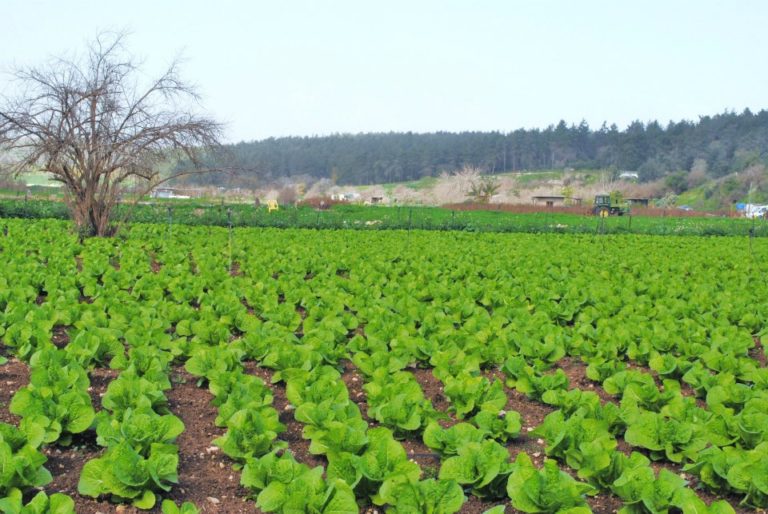
We’re curious…
Why is this year different from other years? This Rosh Hashanah marked the start of a Shmita (often translated as “sabbatical”) year, which occurs every seven years. Just like we are commanded to work for six days and rest on the seventh, the Torah states that every seventh year, after six years of planting and harvesting the Land of Israel should be allowed to “rest.”
During the approximately 2,000 years the Jewish people were in exile, Shmita was largely a theoretical issue. However, once Jews began returning to the Land of Israel en masse in the 1880s, a practical debate emerged over the question of how to observe Shmita. Not tilling the land for an entire year posed obvious economic challenges for farmers who would need to abandon their jobs. The prospect of a year of rest for the land also created hurdles for anyone who wanted to eat produce.
Seeking to address these concerns, rabbis found legal/halakhic ways for Jewish farmers to observe Shmita while continuing to farm the land. They created a “heter mechira” (a sale permit); this allowed Jewish farmers to “sell” their land to non-Jews, and then continue working the land and selling the produce under certain conditions. However, the heter mechira became a subject of controversy: while the religious Zionist community supported the measure, some in the Haredi community argued that this was not properly observing Shmita.
At the start of a new Shmita year, we wanted to unpack: What is Shmita all about, and what does it look like in Israel? What do Israelis think about observing this Biblically-mandated year in a modern Jewish state?
The origins of Shmita
Shmita literally means “release” and is discussed in three passages in the Torah. Here are short excerpts from them that reveal different aspects of this Biblical year of rest:
- “Six years shall you sow your land and gather in your yield; but in the seventh year, you shall let it rest and lie fallow. Let the needy among your people eat of it, and what they leave let the wild beasts eat.” (Shemot / Exodus 23: 10-11)
- “But in the seventh year, the land shall have a Sabbath of complete rest, a Sabbath of the Lord: you shall not sow your field or prune your vineyard.” (Vayikra / Leviticus 25:4)
- “Every seventh year, you shall practice remission of debts…every creditor shall remit the due that he claims from his fellow; he shall not exact payment from his fellow or kinsman, for the remission proclaimed is of the Lord.” (Devarim / Deuteronomy 15: 1-2)
You can see the different themes of Shmita in these verses. In Exodus, the commandment to let the land rest is associated with the Torah’s concern for those in need as well as for animals. The verses in Leviticus present Shmita as a year of rest for the sake of the land. Rabbi Julian Sinclair, who translated an essay by Rabbi Abraham Isaac Kook about Shmita, elaborates on this: “This is our duty of stewardship to the earth. We should not treat it as merely a resource to be perpetually exploited for our benefit; the land must also rest.”
The passage from Deuteronomy adds that debts are to be forgiven during Shmita. The passage goes on to describe the obligation of giving tzedakah (charity) and not withholding loans to the poor. This further underscores the connection between Shmita and the goal of creating a just and equitable society.
History of Shmita
Rabbi Sinclair explained the history of Shmita observance in ancient Israel:
There is strong evidence that the sabbatical for the land was observed throughout the Second Temple period. At the famous assembly described by Nehemiah on their return to Israel in 516 BCE, the Jews took upon themselves the observance of Shmita (Neh. 10:32)… Numerous tannaitic sources attest that Jews in Israel continued to observe Shmita for centuries after the destruction of Jerusalem by the Romans. After most Jews were exiled, Shmita for the land (shmitat karka’ot) lapsed, as it is binding only on Jews living in the Land of Israel.
Sinclair went on to describe the history of the first Shmita year after the First Aliyah, in 1888:
With the advent of the Shmita of 1888, it was clear to the pioneers that observing the sabbatical year as commanded in the Bible would be economically ruinous and would likely lead to the extinction of the nascent agricultural settlements. For a solution, they appealed to European rabbis…who ruled that they might continue to work the land in the sabbatical year, provided that the land was sold to non-Jews for the duration of the Shmita. This leniency was patterned after the permission to sell ḥametz, leavened food, to non-Jews during Passover in order to avoid serious financial loss.
The heter mekhira, as it became known, was seen as a temporary expedient. It was renewed for the Shmita years of 1895 and 1902, each time amid bitter criticism from the Old Yishuv [traditional Orthodox Jews who had emigrated to the Land of Israel to study Torah and pray], which was not engaged in agriculture and saw the heter as a specious device for avoiding a biblical commandment.
In 1909, the Zionist leader Rabbi Abraham Isaac Kook (commonly known as Rav Kook) wrote “Shabbat Haaretz” (Sabbath of the Land), in which he made a halakhic case in support of the heter mechira. Rav Kook strongly supported the Jews returning to and farming the land, and wanted to find a halakhic way for farming to continue. Sinclair summarized Rav Kook’s basic view on the Shmita controversy:
The very viability of Judaism…was on the line. If the halakhah could provide no solution to the most pressing existential needs of the farmers, they would turn their backs on Judaism in droves… if the rabbis showed themselves to be oblivious to the most basic needs of life, the result would be the destruction of Torah and the abandonment of mitzvot.
The publication of “Shabbat Haaretz” generated more controversy on the subject. Rabbi Ya’akov David Willowsky (known as the “Ridbaz”), who was the rabbi of Tzfat, argued that heter mechira did not change the status of the land and was a blatant transgression of the Biblical commandment of Shmita. The Ridbaz purchased a plot of land before the Shmita year of 1909 just so he could let it lie fallow. (Some Orthodox Israelis continue to do this before Shmita years today.)
When the State of Israel was founded in 1948, the Chief Rabbinate adopted heter mechira as a standard part of the Shmita year. In 2007, the Chief Rabbinate slightly changed its policy, declaring that each regional rabbinate could decide whether to give kosher certification to produce grown under a heter mechira. However, Israel’s Supreme Court ordered the Rabbinate to rescind its ruling and maintain the national policy of heter mechira.
Orthodox Jews who observe more stringent standards of Shmita often purchase Arab-grown produce or produce from abroad. They can also buy fruits and vegetables through the Otzar Haaretz (“Treasure of the Land”) program, which supplies produce collected from the previous year; fruits and vegetables grown in nutrient-enhanced water that never touch the ground; and produce from the Arava desert and parts of the Negev, which are considered to be exempt from Shmita observance.
Perspectives from Israelis
In a Jerusalem Post op-ed, David Weinberg, vice president of the Jerusalem Institute for Strategy and Security, highlighted the economic and practical challenges posed by full Shmita observance, while arguing that “primary reliance on Arab produce is neither realistic nor acceptable for health, nationalist and religious reasons.”
Weinberg advocated for a “nationally responsible” solution that balances a range of priorities, including ensuring the public “has access to basic kashrut and is not forced into absolute violations of tradition”; “maintaining an economically viable Jewish agricultural sector”; and protecting the Land of Israel from creeping Arab annexation.”
In a piece for eJewish Philanthropy, Rabbi Julian Sinclair argued that “creative adaptations of Shmita values” for the 21st century could bring Diaspora and Israeli Jews closer together. Shmita “has unique potential to promote the value of peoplehood that spans geography, politics and other axes of division,” he wrote.
For example, Sinclair highlighted a joint effort by government banks and NGOs “to bring 5,000 families out of crippling long-term debt through…partial debt relief, rescheduling of loans and counseling on financial planning.” He wrote that left-leaning groups in the American Jewish community could proudly identify with projects like this one.
One initiative that is working to expand awareness of Shmita and its relevance to society today is The Shmita Project. “We…want to explore the ways that traditional teachings about Shmita shed light on a significant range of contemporary issues…including rest and work, relationship to land, relationship to community, relationship to debt and debt relief, definitions of community, and the issue of consumption itself,” the project’s website states. For example, this short video focuses on how Shmita is “changing the rules of the game in the race of life.”
Daniel Taub, former Israeli Ambassador to the U.K., wrote poetically about the potential of Shmita as a universal Shabbat, writing, “[Shmita is a] time to see ourselves not in terms of what we do, but what we are, and even what we might become… For any of us, to learn that instrument, to write that book, to try the path we never took… The cost — decommissioning a seventh of the productive workforce — might sound steep. But it is an investment with potentially exponential rewards.
“For the workplace: a continuous stream of invigorated employees, brimming with insights and experiences; for families: a time for reacquaintance and renewal; for society: an opportunity for caring individuals to devote not just the margins of their weeks but the very kernels of their days to the underprivileged…”
The bottom line
The question of how Israel should observe Shmita raises an even bigger question: What does it mean for Israel to be a Jewish state, culturally, halachically and nationally? For some in the Orthodox community, Shmita observance in a modern Jewish state should include a heter mechira; others maintain that a heter mechira is not stringent enough and that the land must be allowed to rest. Meanwhile, others are focusing on how Shmita promotes values like social justice, tzedakah, sustainability, land and rest.
On an even broader level, Shmita is one example of how the experiences of Jews living in Israel and the Diaspora are different. There is a world of halakha and Judaism in Israel that could be seen as largely irrelevant to Jews in the rest of the world. At the same time, some like Rabbi Sinclair argue that Shmita is an opportunity to bring the entire Jewish world closer together. If we understand Shmita to promote Jewish and universal values that we all share, then perhaps this year is a rare opportunity to improve that relationship.
Originally Published Sep 20, 2021 12:03AM EDT


